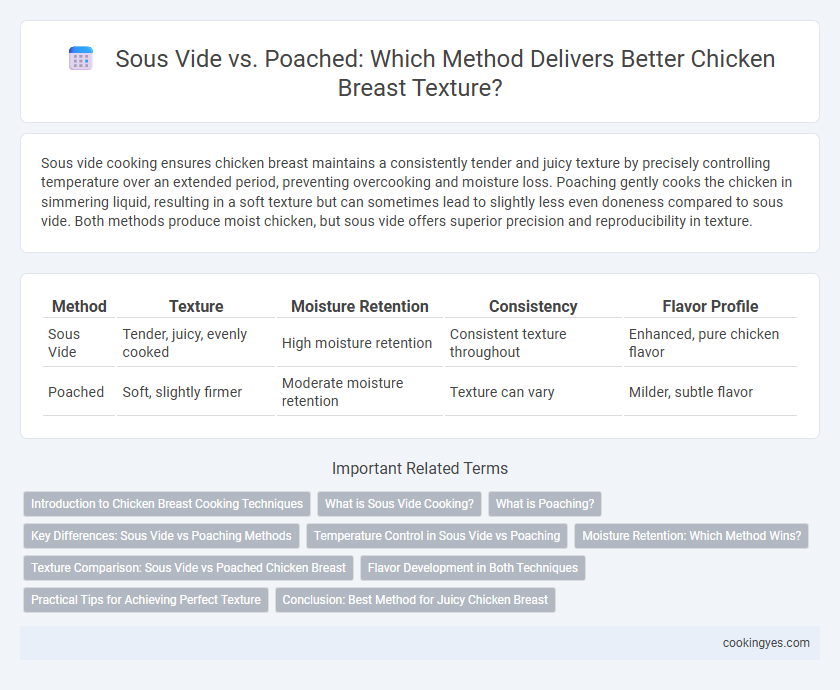Sous vide cooking ensures chicken breast maintains a consistently tender and juicy texture by precisely controlling temperature over an extended period, preventing overcooking and moisture loss. Poaching gently cooks the chicken in simmering liquid, resulting in a soft texture but can sometimes lead to slightly less even doneness compared to sous vide. Both methods produce moist chicken, but sous vide offers superior precision and reproducibility in texture.
Table of Comparison
| Method | Texture | Moisture Retention | Consistency | Flavor Profile |
|---|---|---|---|---|
| Sous Vide | Tender, juicy, evenly cooked | High moisture retention | Consistent texture throughout | Enhanced, pure chicken flavor |
| Poached | Soft, slightly firmer | Moderate moisture retention | Texture can vary | Milder, subtle flavor |
Introduction to Chicken Breast Cooking Techniques
Sous vide cooking ensures precise temperature control for chicken breast, resulting in consistently tender and juicy texture by cooking it evenly throughout. Poaching, a gentle cooking method in simmering liquid, produces a softer but sometimes less uniformly cooked chicken breast texture. Both techniques preserve moisture better than traditional high-heat methods, enhancing the overall eating experience of chicken breast.
What is Sous Vide Cooking?
Sous vide cooking involves sealing chicken breast in an airtight bag and immersing it in a water bath at a precisely controlled low temperature, typically between 140degF and 160degF, to ensure even doneness and tender texture. This method preserves moisture and prevents overcooking, resulting in a juicy, uniformly cooked chicken breast with a delicate texture. Unlike poaching, which cooks the chicken in simmering liquid at higher temperatures, sous vide allows for greater control over texture and flavor retention.
What is Poaching?
Poaching chicken breast involves cooking it gently in a simmering liquid, typically water, broth, or wine, at a temperature just below boiling, around 160-180degF (71-82degC). This method ensures the chicken remains tender and moist while preventing it from becoming tough or dry. Compared to sous vide, poaching offers a more accessible technique that imparts subtle flavor from the poaching liquid, though it may lack the precise temperature control that results in a consistently smooth texture.
Key Differences: Sous Vide vs Poaching Methods
Sous vide cooking ensures chicken breasts have precise temperature control, resulting in consistently tender and juicy texture by slowly cooking the meat in a vacuum-sealed bag at a low temperature. Poaching involves simmering chicken breasts in water or broth at a higher temperature, which can cause slight firmness and variability in texture due to less precise heat control. The key difference lies in sous vide's ability to cook evenly throughout without drying, while poaching may risk overcooking or uneven doneness.
Temperature Control in Sous Vide vs Poaching
Sous vide cooking allows precise temperature control, typically maintaining chicken breast at 140degF to 150degF for tender, evenly cooked texture without risk of overcooking. Poaching involves cooking chicken breast at a simmering temperature around 165degF, which can cause slight unevenness and a firmer texture due to fluctuating heat. The controlled environment of sous vide ensures consistent doneness, making it superior for achieving moist, juicy chicken breast compared to traditional poaching methods.
Moisture Retention: Which Method Wins?
Sous vide cooking excels in moisture retention for chicken breasts by maintaining a precise, low temperature that prevents overcooking, resulting in tender, juicy meat. Poaching, while gentle and capable of producing moist chicken, often leads to more water loss due to direct immersion in simmering liquid and temperature fluctuations. Scientific studies on protein denaturation confirm that sous vide's controlled environment preserves more moisture compared to poaching, making it the superior method for juicy chicken breasts.
Texture Comparison: Sous Vide vs Poached Chicken Breast
Sous vide chicken breast offers a consistently tender and juicy texture due to precise temperature control, preventing overcooking and moisture loss. Poached chicken breast tends to have a softer, slightly firmer texture but can become dry or rubbery if overcooked because of direct exposure to boiling water. Temperature consistency and cooking duration play crucial roles in determining the final texture of both sous vide and poached chicken breast.
Flavor Development in Both Techniques
Sous vide cooking of chicken breast enhances flavor development by allowing precise temperature control, which preserves moisture and intensifies natural poultry juices over extended cooking times. Poaching gently infuses the chicken with subtle flavors from the cooking liquid while maintaining a tender texture, but can result in milder taste compared to sous vide. Both techniques ensure juicy chicken breasts, yet sous vide offers a deeper, more concentrated flavor profile due to improved protein denaturation and retention of aromatic compounds.
Practical Tips for Achieving Perfect Texture
Sous vide cooking ensures precise temperature control, resulting in chicken breast with consistent juiciness and tenderness by gently cooking at a controlled low heat, typically between 140degF to 150degF for 1 to 2 hours. Poaching requires careful attention to maintain water temperature just below boiling (around 160degF to 180degF) and to avoid vigorous bubbles that can toughen the meat, emphasizing gentle simmering for about 15 to 20 minutes. For perfect texture, always use a thermometer for temperature accuracy, avoid overcooking, and rest the chicken briefly after cooking to allow juices to redistribute.
Conclusion: Best Method for Juicy Chicken Breast
Sous vide offers precise temperature control that yields perfectly tender and uniformly juicy chicken breast by gently cooking it over an extended period. Poaching, while quick and simple, can result in uneven texture and less moisture retention due to higher heat exposure. For consistently juicy and succulent chicken breast, sous vide remains the superior cooking technique.
Sous Vide vs Poached for Chicken Breast Texture Infographic

 cookingyes.com
cookingyes.com